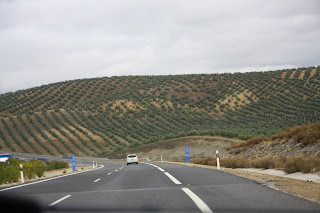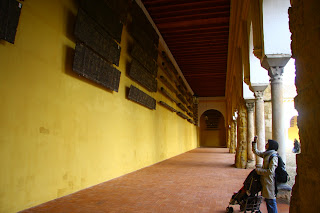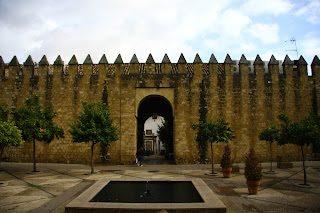Jelajah Andalusia Sepanyol - Cordoba
Cordoba is situated 160km on the northside of Malaga or one hour and 45 minutes drive from Malaga via A45 highway. It was conquered by invading Islamic armies in the eighth century, and then became the capital of the Islamic Emirate and then Caliphate of Córdoba, including most of the Iberian Peninsula. Under the rule of Caliph Al Hakam II, Cordoba had also become a centre for education under its Islamic rulers. Al Hakam II opened many libraries in addition to the many medical schools and universities which existed at this time. During these centuries Córdoba became a predominantly Muslim society with minorities living in a restricted second-class status. It returned to Christian rule in 1236, during the Reconquista.
Córdoba has the second largest Old town in Europe, the largest urban area in the world declared World Heritage by UNESCO. The most important building and symbol of the city, the Great Mosque of Córdoba and current cathedral, alongside the Roman bridge, are the best known facet of the city.
Along the journey to Cordoba, we could rows and rows of olive trees in the orchards. The scenery in Southern Spain is mostly sparse with mostly plain almost desert-like terrain with only small trees such as olive trees and bushes here and there due to hot and dry Mediterranean weather. The traffic was quite good and we made few stops just to absorb the panoramic view.
Upon arriving Cordoba, we targeted to visit the famous Cordoba Mosque or currently is known as the Mezquita de Cordoba. The site of the mosque was originally built as the Catholic Basilica of Saint Vincent of Lérins.When Muslims conquered Spain in 711, the church was first divided into Muslim and Christian halves which lasted until 784, when the Christian half was purchased by the Emir 'Abd al-Rahman I, who then proceeded to demolish the entire structure and build the grand mosque of Cordoba on its ground. Córdoba returned to Christian rule in 1236 and the building was converted to a Roman Catholic church, culminating in the insertion of a Renaissance cathedral nave in the 16th century.
 The Great Mosque has two different areas: the courtyard or “arcade sahn“, where the “alminar” (minaret) is constructed (beneath the Renaissance tower) by Abd al-Rahman III, and the “haram” or praying hall. The interior space consists of a forest of columns and red and white arches giving a strong chromatic effect. The site is divided into 5 different areas, corresponding each one of them to the different expansions that have occurred on it.
The Great Mosque has two different areas: the courtyard or “arcade sahn“, where the “alminar” (minaret) is constructed (beneath the Renaissance tower) by Abd al-Rahman III, and the “haram” or praying hall. The interior space consists of a forest of columns and red and white arches giving a strong chromatic effect. The site is divided into 5 different areas, corresponding each one of them to the different expansions that have occurred on it.
The Mosque of Abderraman I
Abderraman I built, in 785, a colossal hall consisting of 11 longitudinal naves, going from North to South, and 110 columns, the capitals and fusts of which were re-used from old Roman and Visigoth materials. This first Mosque has an unorthodox orientation, facing south, like the Great Mosque of Damascus. Another characteristic of the Mosque of Cordoba is the use of horseshoe arches introduced in the Islamic architecture. The naves are divided by double arches to help support the weight of the higher ceilings. The double arches, then an architectonic novelty, consist of a lower horseshoe arch and an upper semi-circular arch.
The Cathedral of Cordoba
 In the early 16th century, the Bishop of the Cathedral got the permission from Carlos V (Charles V, King of Spain) to construct inside the Great Mosque. Both, the Bishop and the King, coincided in the need to respect the expansion made under the rule of Alhakem II . So, in 1523, the construction of the Cathedral of Cordoba started under the direction of the Spanish architect Hernán Ruiz I . After many discussions, they finally decided to insert the new Cathedral in the very heart of the former Mosque, which meant tearing down the center of the Mosque (This is the saddest part of the Mosque! I almost cried to see there were so many Christian relics inside the mosque).
In the early 16th century, the Bishop of the Cathedral got the permission from Carlos V (Charles V, King of Spain) to construct inside the Great Mosque. Both, the Bishop and the King, coincided in the need to respect the expansion made under the rule of Alhakem II . So, in 1523, the construction of the Cathedral of Cordoba started under the direction of the Spanish architect Hernán Ruiz I . After many discussions, they finally decided to insert the new Cathedral in the very heart of the former Mosque, which meant tearing down the center of the Mosque (This is the saddest part of the Mosque! I almost cried to see there were so many Christian relics inside the mosque).
The Courtyard of the Orange Trees
The Naranjos Courtyard (the Orange Tree Courtyard) was used for public activities in the Islamic period, such as teaching or for justice purposes. The arches that go from the praying hall to the courtyard were opened. From the beginning it was conceived as a courtyard with a colonnade.Under the orange trees there is a large aljibe (water tank) that provided water for the Muslim's purifications. In the 13th century palm trees were planted.
The Tower of the Mosque of Cordoba
Abderraman III built the Alminar (minaret: Tower to call for prayer), which still remains in the actual bell tower with remodelling and mended was done in 1593. The works on the tower continued in the 17th century, and Juan Sequero de Matilla built the Clock's tower.
We read signboards inside the mosque that do not allow Muslims to pray inside the Mosque. Now we know why. Since the early 2000s, Spanish Muslims have lobbied the Roman Catholic Church to allow them to pray in the cathedral but has been rejected on multiple occasions, both by the church authorities in Spain and by the Vatican.
The Roman Bridge or "Puente Romano"
After the Mezquita, we took a stroll along Rio Gualdalquivir and acrossed the the Roman bridge . The "Puente Romano" consists of sixteen arches, four pointed arches and the rest semicircular arches, supported by strong abutments with semi-cylindrical elements. The bridge was first built in the 1st century A.D., but has been rebuilt many times since then, and in its present form dates mainly from the Medieval period, with the latest changes being made in 1876. At the center of the breastwork there is a sculpture of “San Rafael”, made in the 16th century (1651) by “Bernabé Gómez del Río”. The brick bonds were in Moslem style. This bridge joins the city with the “Calahorra” castle, and it is said that “Julio Cæsar” could have ordered its construction.
The Calahorra Tower of Cordoba
At the southern end of the Roman Bridge stands the Calahorra Tower of Cordoba, an ancient defensive fortress which is mentioned in a number of Arab sources on “Al-Andalus” (Arab Andalusia), as well as historical records ever since the Christian conquest of Cordoba. Its architecture reflects the successive renovations made to the tower. The horseshoe archway serves as an additional entrance gate, and its rectangular enclosure flanked by towers was rebuilt in the 12th century.

Around Cordoba City
~yatiseman~
















































Comments
Post a Comment
Terima kasih atas mesej anda. Saya akan menjawab mesej anda seberapa segera. Stay safe!
Thank you for your message. I will attend to your messages soonest possible. Stay safe!